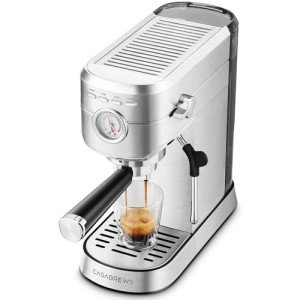15 Things You're Not Sure Of About Stainless Steel Espresso Machines
The Art of Italian Espresso Machines: A Brewed Tradition
Italian espresso machines are not simply home appliances; they are an integral part of Italy's rich coffee culture, representing a mix of artistry, engineering, and style. Coffee connoisseurs around the world acknowledge the value of high-quality espresso, a staple of Italian life and cuisine. This article checks out the history, mechanics, types, and factors to consider when buying an Italian espresso machine, showing the depth of this precious drink and its brewing methods.
History of Espresso Machines
The espresso machine's advancement dates back to the early 20th century in Italy, where coffee was not simply a drink however a vital social routine. The initial efforts to brew espresso started with easy, stove-top models, gradually progressing into intricate machines that might replicate the best brew.
- 1901— The First Espresso Machine: The very first steam-powered espresso machine, referred to as the “Ideale,” was established by Luigi Bezzera. This equipment marked a turning point in espresso brewing.
- 1938— The Lever Machine: The intro of the lever machine made it much easier to control the pressure used in espresso extraction, enhancing taste consistency.
- 1947— The Automatic Machine: Reaching more customers, Gaggia introduced the very first automatic espresso machine, further promoting espresso bars.
- 2007— The Digital Age: Technological developments resulted in the birth of fully programmable machines, enabling users to tailor their developing settings to accomplish a customized coffee experience.
Secret Features of Italian Espresso Machines
Italian espresso machines embody precision, workmanship, and development. Here are some essential components that highlight their significance:
Feature
Description
Boiler Type
Determines how heat is produced and maintained. Common types include single boiler, dual boiler, and heat exchanger.
Group Heads
Where the coffee is brewed; commercial machines frequently have several group heads for effectiveness.
Pressure Control
Vital for achieving the best espresso; most machines run at 9 bars of pressure.
Frothing Capabilities
The steam wand permits milk frothing, essential for beverages like cappuccino and latte.
Develop Quality
The products utilized (stainless-steel, brass, etc) influence durability and heat retention.
Types of Italian Espresso Machines
Selecting the right machine depends upon user preferences, budget, and intended use. Below are the main types of Italian espresso machines:
Manual Espresso Machines
- Pros: Offer complete control over the brewing process, permitting an individualized touch.
- Cons: Require skill and practice, can be labor-intensive.
Semi-Automatic Machines
- Pros: Provide a balance in between automatic and manual procedures; users manage water circulation.
- Cons: Can have a steeper learning curve than completely automatic machines.
Fully Automatic Machines
- Pros: Simplify the developing process with push-button operations; suitable for novices.
- Cons: May compromise some of the nuances of manual developing.
Super-Automatic Machines
- Pros: Grind, tamp, brew, and froth automatically; hassle-free for hectic way of lives.
- Cons: Less control over the brewing variables, capacity for a less authentic espresso experience.
Purchasing Guide: Factors to Consider
Choosing the perfect Italian espresso machine can be difficult, however considering the following elements can simplify the decision-making process:
- Budget: Italian espresso machines vary from affordable to high-end models, so set a budget upfront.
- Usage Frequency: Evaluate how often you will use the machine; daily users may want a more resilient choice.
- Space: Measure your kitchen or counter space; some machines can be large and need sufficient clearance.
- Maintenance: Consider ease of cleansing; machines with detachable parts or built-in cleansing features might minimize maintenance.
- User Skill Level: Beginners may prefer fully or semi-automatic machines, while knowledgeable baristas can handle manual machines.
- Brand name Reputation: Research brands known for quality, such as Breville, Gaggia, and La Marzocco.
Popular Italian Espresso Machine Brands
Italian craftsmanship is renowned for producing a few of the best espresso machines worldwide. Here are top brands worth considering:
- Gaggia: Known for its home espresso machines and cost.
- La Marzocco: An exceptional brand understood for its commercial-grade machines and ingenious technology.
- Rancilio: Renowned for its long lasting build and professional-quality machines ideal for home and commercial use.
- Sage/Breville: Offers advanced features and user-friendly designs, best for both amateurs and enthusiasts.
FAQs
What is the distinction between espresso and regular coffee?
Espresso is a focused coffee brewed by forcing warm water through finely-ground coffee under pressure. Affordable Espresso Machines has a thicker consistency, richer flavor, and greater caffeine concentration than routine coffee.
Can I make milk-based beverages with an espresso machine?
Yes, many Italian espresso machines come with a steam wand to froth milk for drinks like coffees, lattes, and macchiatos.
How frequently should I clean my espresso machine?
Regular maintenance is necessary. Typically, an extensive cleaning is recommended every couple of weeks, while descaling must be done every 1 to 3 months, depending upon water hardness.
What is the perfect pressure for brewing espresso?
The ideal pressure for developing espresso is around 9 bars. This pressure makes sure the optimum extraction of flavors from the coffee premises.
Are more pricey machines worth the financial investment?
Higher-end machines often make use of much better materials and technology, supplying enhanced sturdiness and more constant results. For serious coffee fans, purchasing a good machine can elevate the espresso experience considerably.
Italian espresso machines are a lot more than mere developing gadgets; they are an event of a cultural custom that has actually affected coffee consumption worldwide. With numerous models available to fit any user's needs— ranging from novices to seasoned baristas— there is an Italian espresso machine perfectly fit for everybody. As you embark on your espresso journey, comprehending the history, mechanics, and alternatives will improve your experience and appreciation for this time-honored beverage. Whether you seek to recreate a café ambiance at home or refine your brewing technique, these machines are capable of providing unforgettable cups of espresso decorated with the rich history of Italian coffee culture.
